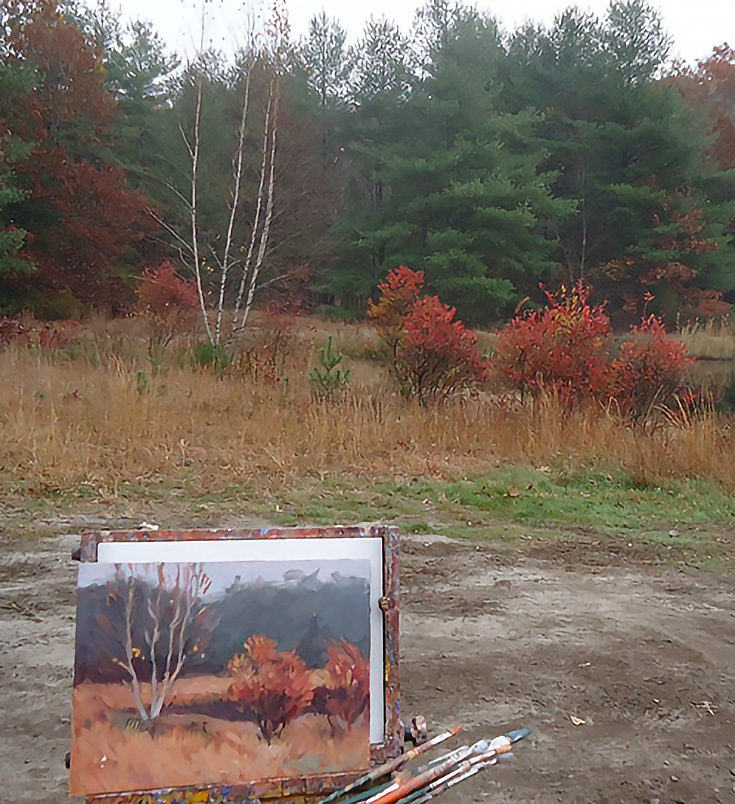November and December are not normally months that you would plan on taking a painting class outdoors, but this winter has been warm enough that on some days we brave the elements.
With each class, I wait until the night before to decide whether I will take them out or not, and each morning I carefully listen for complaints from my students if it’s near or below 50 degrees.

So far, I’ve been happy that my classes are hardy and no one has complained. We’ve never been uncomfortable and always created some really exciting work.
Is it ever too cold to paint?
As a painter, I’ve always enjoyed winter plein air opportunities. I just returned from a short trip up to Ashland, New Hampshire for a quick painting trip with a few of my friends. The forecast was COLD and getting COLDER. . . so much so, that I was a little apprehensive about going since I am not a spring chicken anymore, and was worried I couldn’t handle the cold like I used to.
But we ended up doing two paintings one day and one more the next before heading home. We dressed in many layers and found some nice spots and hunkered down. Each day was in the low 40’s and the second day was windy to boot. After each painting session, we were definitely chilled, but we got almost three hours of good painting in each time.
In my experience, I have found that if the weather is 40 degrees or higher, it is very manageable to paint outdoors. The variable is the wind. If there’s wind, it’ll go through you very quickly.
My personal painting limit is around 20 degrees. Any colder than that, and it’s just not worth it to me. It can also be dangerous—one friend of mine who tried painting in below zero weather ended up with frostbite, which will affect her for the rest of her life.
Some days when it’s too cold, or too windy, I just paint in my car. It’s not perfect, but it helps cut the wind and chill, and I don’t lose out completely on a great painting day.
How to prepare for cold weather painting
At the very least, you’ll need many layers of clothes and good, warm boots to get you through. Nowadays there are also heated vests, boots and gloves you can buy, to keep you truly warm. I’d also recommend picking up some of those heated pads that activate when you open them—these are great to help you warm up after painting, if not during.
The first thing to go cold on me is my hands. I can bundle up everywhere else, but if my gloves are too bulky, I can’t hold my brushes, so I use thin gloves and my hands always feel it. I sometimes wear latex gloves over another pair to cut any wind-chill, but that can add some difficulty for me because I have arthritis in my fingers.
My pair of Cabela boots, on the other hand, could help me survive -145 degrees, so my feet are the last thing to go cold. Good boots are essential, as well as a hot thermos, to warm up your insides as you paint. Coffee, tea, cocoa, whatever you prefer, just don’t forget to pack it or you’ll be kicking yourself.
I love taking my students out on cold days, mainly because I want to show them how do-able 40 degrees can be. In my area, a lot of the winter is 40 degrees, so there are always days you can paint. Plus, winter scenes are just so subtle and interesting.
If you’re lucky enough to go out after a thick snow, for example, your landscape will have a lot of white, and won’t need a lot of details. You’ll be surprised how much you can get done in a little time. I am never disappointed when I go out after a snowfall and put in the work.
The trick is to just go DO IT. If I think to myself, “Oh, I have to put on long johns and find my boots and wear all of those layers” and so on, I’ll talk myself out of going every time. But if I am disciplined and force myself out there, I am always glad I went.
For more paintings and articles by Dianne, please visit www.DiannePMiller.com.
This post may contain affiliate links.


